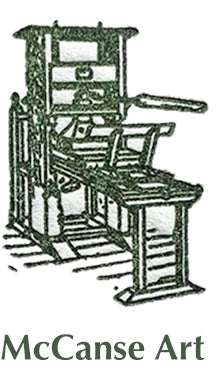Caroline Armington
Caroline Helena Armington (1875-1939) was born in Brampton, Ontario, to a farm implement businessman. As Caroline Wilkinson, she had to contend for her place in the art world. Her introduction to this world came through J.W.L. Forster, her father’s cousin and a portrait painter for several Canadian prime ministers, among them Alexander Mackenzie. Caroline developed an early interest in art, and for seven years, she spent her weekends traveling to Toronto to study with Forster; it was here that Caroline met Frank Armington, fellow student of Forster’s and Caroline’s future husband.

PAMA, 1981.1966
But Caroline’s interest in art and her desire to study it in Europe was entirely against her parents’ wishes. She was pushed to pursue nursing and trained for this at Guelph General Hospital. Her parents would not support her in her wish to study art, and Caroline was forced to find her own means to do so. Frank went to Europe just before the turn of the century, and after a brief period spent working as a teacher in Halifax and as a nurse elsewhere, Caroline built up the funds to follow suit to Paris in 1900.
In Paris, Caroline was exposed to a culture and excess of art incomparable to what she’d seen in Brampton. She studied at the Academie de la Grand Chaumiere and subsequently at the Academie Julian, both of which were relatively inexpensive schools that Caroline could afford on her own savings. While studying in Paris, Caroline turned her focus to etching. Caroline had an unusual method when working in this medium: rather than drawing a pencil sketch of her scene that would serve as a draft from which an etching would be designed, Caroline etched what she saw directly onto the plate. It would be for her work in this medium (as well as her prolific output) that Caroline would stake her claim in the art world.

NY: American Historical Society, 1941. pp. 391−392
However, it was not long into her stay in Europe that Caroline’s work was interrupted; her family was pushing her to return to nursing, and in the early 1900s, the Armingtons moved back to Canada. If Caroline was disheartened at this turn of events, she might have found it especially difficult that while she was working both in hospitals and offering private nursing lessons, Frank landed his first exhibition. It was also around this time that Frank became the first vice-president of the Manitoba Society of Artists.
Caroline would not be able to continue her work until 1905, when the couple managed to return to Paris; soon after her return, Caroline produced some of her most notable etchings, including Napoleon’s Tomb (Paris), Notre Dame et Pont St. Michel (Paris), Rue De L’Arc (Constantine), pictured left. As her style refined and Caroline improved mastery of the technique, Caroline was lauded for her control of line and light, and she soon earned herself some impressive commissions, one of which was a direct order from the United States Government for an etching of the White House. Caroline’s work was later exhibited at a solo show in the Corcoran Gallery in Washington, an unusual Canadian presence in a gallery largely focused on American art.

Caroline’s art was gaining attention in Europe as well; in 1908 Caroline was accepted to exhibit her painting Paysanne Hollandaise at the Salon des Artistes Francais’ annual exhibition in Paris—but Frank wasn’t. A.Y. Jackson, guest and friend of the Armingtons, noted in a letter to his mother that this was Frank’s third rejection.
In 1939, during an air-raid alarm, Caroline suffered a heart attack, and the Armingtons made the decision to leave Europe for New York. Three days later, Caroline died. Frank remarried in 1940 but himself died a year later in 1941. His second wife and step-daughter moved soon after and reportedly destroyed much of the Armingtons’ photographs and other personal material, leaving us little of their own words and work to flesh out the picture of their lives, not only as a couple but also as individual artists.

During her career, Caroline Armington produced 557 etchings and drypoints. Her work is acclaimed for its faithful reproduction of architectural detail and attention to light, and Caroline herself remains an integral figure in Canadian art history, having made her mark despite the pressures she faced, not only from her family but as an early female artist fighting for recognition in her own right; and while some had discouraged Caroline from signing her works with her given name in favour of the more “gender neutral” look of using only her initials, Caroline didn’t hide—her works are all signed “Caroline H. Armington.”
Today, her etchings can be found in many Canadian and international public and private collections, including the permanent collection of the National Gallery of Canada (Ottawa), the Victoria & Albert Museum (London, England), and the Metropolitan Museum of Art (New York).

Credit: Braide, Janet; Parke-Taylor, Nancy. Caroline and Frank Armington: Canadian Painter-Etchers in Paris. Art Gallery of Peel, 1990.
Written by Mina Ivosev.
Sources:
Braide, Janet, and Nancy Parke-Taylor. Caroline and Frank Armington: Canadian Painter-Etchers in Paris. Art Gallery of Peel, 1990.
“Caroline Armington.” Wikipedia, Wikimedia Foundation.
“Caroline Helena Armington.” Hodgins Art Auctions Ltd..
Moreau, Nick. “Caroline Armington, a Canadian Artist in Paris.” Peeling the Past, Region of Peel Archives, 11 Mar. 2016.
